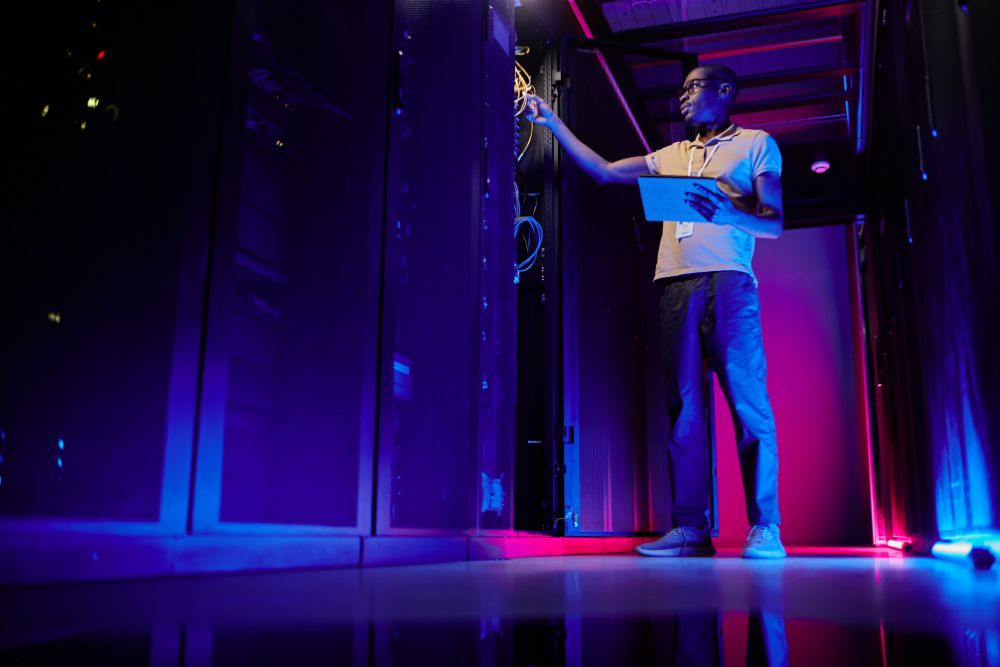Expanding into the UK market is an exciting step, and London continues to be the top choice for US-based firms looking to establish a European presence. From access to international clients and investors to the capital’s vibrant and diverse talent pool, the city offers clear advantages. But your success hinges on one often overlooked detail: your IT strategy.
Getting your technology roadmap right from the outset will save time, prevent disruption, and support productivity as you scale.
Based on our experience helping US companies expanding in London, We have put this guide together to walk you through some considerations to build a robust, compliant, and future-ready office.

1. The Pre-move planning
Assessing your requirements
The decision has been made, the board has approved the budget and you are eager to start purchasing and signing service contracts for your new office in London. But before you start, it’s worth taking a step back and defining what your London team truly needs, who they are going to be in the beginning and how the office is going to evolve in the next few years.
Consider the size of your initial headcount, whether roles will be remote, hybrid, or fully office-based, and the kinds of work they’ll be doing day to day. For example, an office based team focused on business development may need high-quality video conferencing facilities, high noise cancelling set ups etc..while a hybrid technical development team may require fast and secure access to cloud-based development tools. Clearly identifying who your end customer is will help you to define the technology requirements for your new office.
Understanding this context also helps ensure your systems can scale. You don’t want to invest in short-term solutions that need replacing in six months.
Connectivity is key
A lot of office spaces offer within their contracts the network connectivity for your new office and although this may sound attractive from a cost point of view, your internet connectivity is one of the first and most critical steps and should be thoroughly planned.
We all know that consumer-grade broadband won’t cut it. Look for business fibre with symmetric guaranteed upload/download speeds, uptime commitments, and proper SLAs. A service built for higher capacity and availability that gives you options to expand in the future.
A back up connection is always important, especially if you are a SaaS -cloud centric organization. Make sure you determine what the minimum bandwidth you need is and get a second line from a different provider on a different route than your main internet circuit.
On-the-ground support that grows with you
New environments could be daunting and even the most simple things could vary from one country to another.
Establishing a local point of contact for your IT needs can significantly reduce friction and stress as you set up and manage your company expansion. Working with a provider who understands both UK technical standards and the operational expectations of International businesses helps bridge cultural and compliance gaps.
Make sure you check for companies who have experience not only setting up offices in London but that have valuable experience working with US and International firms coming to London. It’s not just about support; it’s about ensuring alignment with how your teams work across both sides of the border.
A strong local support partner means having an extension of your team to deal with onsite issues, requests that cannot wait until your team wakes up and also having an allie that will advise on suppliers, hardware compatibility, and will ease the path of going through all these local nuances and standards.

2. Building your workspace and infrastructure
Network and data infrastructure
Making sure that your HQs technology policies and procedures are adapted to the UK and followed from day one should be a non-negotiable.
Going for temporary set ups is a dangerous trap. In the heat of the moment a “while we get running” set up could sound like a great quick win. But this idea more often than not becomes the foundation for an infrastructure planned to fail.
A secure and stable network is paramount for the smooth operation of your new office. Head count planning will help you to determine what the minimum bandwidth you require should be. Set up segmented Wi-Fi networks from day one; separating guest access from internal traffic is best practice for both performance and security.
Although we live in a wireless dominated world, behind the scenes, structured cabling and high-quality network switches can improve long-term reliability and prevent bottlenecks. Thinking ahead here saves headaches later, especially as your office grows or adopts more bandwidth-heavy tools like video conferencing and large cloud based file backups.
Cloud, Servers and user access
Nowadays modern businesses are relying on cloud platforms for everything from file storage to identity management. However, if your operations include legacy applications, compliance-sensitive data, or specific performance requirements, a physical server setup may still be necessary.
Carefully assess your current infrastructure and long-term growth plans before committing to a direction. Latency and sync issues between new offices and HQ can also be a concern, especially when working with large files. A local IT partner can help ensure these services are optimised for performance from London and configured to comply with regional privacy rules.
Regardless of your set up, ensuring seamless access across locations is essential. It’s worth checking that all authentication and security policies function equally well in the UK, particularly for multi-factor, and Single Sign-On (SSO).
Meeting room and AV setup
Modern offices need more than just a table and a few chairs. Hybrid work is now the norm, and your meeting spaces must be equipped to host both in-person and remote attendees.
Keep it simple; your team should be able to walk in and start a call without a tech headache. Invest in high-quality microphones, cameras, and displays that integrate with your chosen video meeting platform.
Acoustic treatment, lighting, and even screen positioning can also impact the quality of your meetings. Small adjustments here can make a big difference in how professional your company appears to remote stakeholders.
If you plan to have town hall spaces or event spaces at your London office, your tech setup needs to scale beyond the standard office meeting room. From portable Wi-Fi networks and AV hire to digital signage and event IT support, having a provider who understands the logistical and technical aspects of live events can save time and stress.
End user Devices, procurement, and Peripherals
It’s common for companies to underestimate how long it takes to source, configure, and distribute devices to a new team. Hardware must be bought locally as importing it is almost impossible.
Your technology partner should be able to help you to replicate and roll out a consistent device policy at your new location which is compliant with the local data and privacy policies, ensuring that laptops, and phones are delivered pre-configured with company policies, productivity tools, and security software so staff can get to work from day one.
The need for physical tools is still a thing. Multifunction Printers, scanners, and shredders remain common, especially in industries with document-heavy processes. Choose hardware that integrates easily with your existing systems and doesn’t require complex local drivers or software.
Standardising and replicating the same tools that you have at HQs will make it easier for your IT partners and support teams.

3. Security & compliance considerations
Foundations of cybersecurity
Security must be part of your plan from day one, not something to retroactively add once an incident occurs. Installing firewalls at the office perimeter, making sure all your phishing, encryption, antivirus, and remote management tools are installed and working properly should be thoroughly configured and tested.
Having a back up/disaster recovery plan from day one is key as well this will also help you to have a more hybrid approach to the office as users should be able to work from any location with minimum difference.
Beyond tech, you’ll also want to educate your local team. Short security awareness sessions should be held with every single new employee. Knowing how to identify and report suspicious emails and follow good password practices are little steps to avoid some of the biggest cybersecurity risks.
Understanding UK GDPR
It is Important to bear in mind that the UK’s data regulations, especially when it comes to transactions, storing and processing personal information, differ from those in the EU and US and should be factored in from the outset.
The UK has its own version of GDPR. This regulation requires businesses to be transparent about how they collect, process, and store personal data. If your systems were designed with only US compliance in mind, they may need to be adapted. Policies around data retention, consent, access rights, and breach notification all have specific requirements in the UK and should be reviewed with expert guidance.
Final thoughts
Opening a London office is a major milestone, and getting the IT side right ensures a smooth, secure, and successful start.
While it may be tempting to replicate your US systems exactly, a tailored approach that considers local needs, compliance standards, and support expectations will set your team up for long-term success.
Your London office isn’t a satellite; it’s a strategic move. As you scale, your IT infrastructure needs to scale with you. That means planning for things like onboarding waves of new employees, opening additional UK sites, or integrating new tools as your workflows evolve.
Regular technology reviews and roadmap planning, ideally in collaboration with a partner specialising in UK office setup, ensure your systems stay aligned with your business goals and remain efficient over time.
Why One Thirty West?
At One Thirty West we are proud to be a strategic technology partner specialised in helping international companies successfully establish UK operations into London and the UK.
With a track record of helping fast-growing businesses from USA, Silicon Valley and beyond, Our team has supported high-profile clients providing hands-on guidance through every stage of their journey — from infrastructure planning to long-term support.
Whether you’re opening your first office or expanding across Europe, we’re here to make your move seamless.
Get in touch today to speak to a UK-based IT expert who understands the unique needs of US companies.
